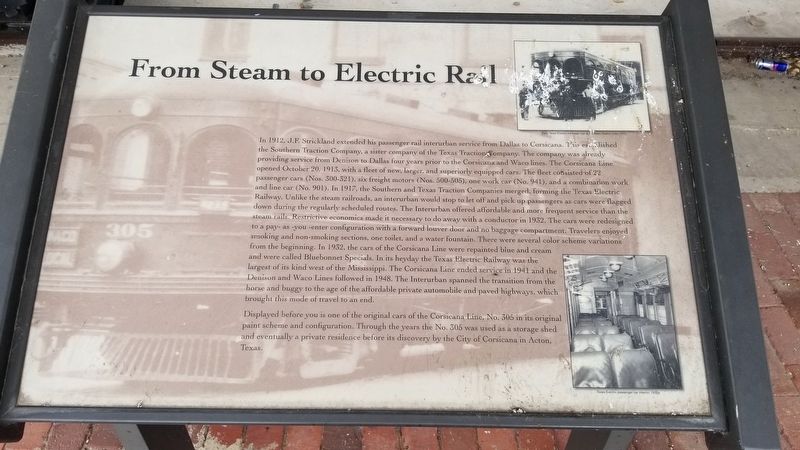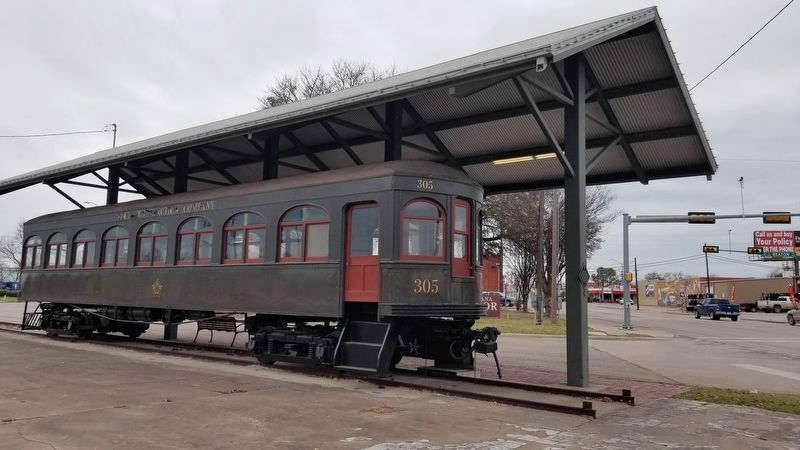Corsicana in Navarro County, Texas — The American South (West South Central)
From Steam to Electric Rail
In 1912, J.F. Strickland extended his passenger rail interurban service from Dallas to Corsicana. This established the Southern Traction Company, a sister company of the Texas Traction company. The company was already providing service from Denison to Dallas four years prior to the Corsicana and Waco lines. The Corsicana Line opened October 20, 1913, with a fleet of new, larger, and superiorly equipped cars. The fleet consisted of 22 passenger cars (Nos. 300-321), six freight motors (Nos. 500-505), one work car (No. 941), and a combination work and line car (No. 901). In 1917. the Southern and Texas Traction Companies merged, forming the Texas Electric Railway. Unlike the steam railroads, an interurban would stop to let off and pick up passengers as cars were flagged down during the regularly scheduled routes. The Interurban offered affordable and more frequent service than the steam rails. Restrictive economics made it necessary to do away with a conductor in 1932. The cars were redesigned to a pay-as-you-enter configuration with a forward louver door and no baggage compartment. Travelers enjoyed smoking and non-smoking sections, one toilet, and a water fountain. There were several color scheme variations from the beginning. In 1932, the cars of the Corsicana Line were repainted blue and cream and were called Bluebonnet Specials. In its heyday the Texas Electric Railway was the largest of its kind west of the Mississippi. The Corsicana Line ended service in 1941 and the Denison and Waco Lines followed in 1948. The Interurban spanned the transition from the horse and buggy to the age of the affordable private automobile and paved highways, which brought this mode of travel to an end.
Displayed before you is one of the original cars of the Corsicana Line, No. 305 in its original paint scheme and configuration. Through the years the No. 305 was used as a storage shed and eventually a private residence before its discovery by the City of Corsicana in Acton, Texas.
Captions
Early Texas Electric Interurban Car at the Waco Station (circa 1917).
Texas Electric passenger car interior, 1930s.
Topics. This historical marker is listed in this topic list: Railroads & Streetcars. A significant historical date for this entry is October 20, 1913.
Location. 32° 5.517′ N, 96° 27.734′ W. Marker is in Corsicana, Texas, in Navarro County. Marker is at the intersection of 7th Avenue (State Highway 31) and South Beaton Street, on the left when traveling west on 7th Avenue. Touch for map. Marker is in this post office area: Corsicana TX 75110, United States of America. Touch for directions.
Other nearby markers. At least 8 other markers are within walking distance of this marker. Capt. Charles Henry Allyn (within shouting distance of this marker); Site of Merchants Opera House
(about 600 feet away, measured in a direct line); The Molloy Hotel (about 700 feet away); Early Texas Natural Gas Pipelines (about 800 feet away); Henry G. Damon (approx. 0.2 miles away); State National Bank of Corsicana (approx. 0.2 miles away); Corsicana Newspapers (approx. 0.2 miles away); First Commercial Oil Discovery in Texas (approx. 0.2 miles away). Touch for a list and map of all markers in Corsicana.
Also see . . . Texas Electric Railway.
The merged company operated three routes out of Dallas, one to Sherman and Denison, one to Ennis and Corsicana, and one to Hillsboro and Waco. With a length of 226 miles, the Texas Electric was the longest interurban between the Mississippi River and California. The company was a local Dallas undertaking promoted by J. F. Strickland. Although built to high standards, the company used streetcar tracks to reach its terminal in downtown Dallas. Source: The Handbook of Texas(Submitted on March 5, 2021, by James Hulse of Medina, Texas.)
Credits. This page was last revised on March 5, 2021. It was originally submitted on March 5, 2021, by James Hulse of Medina, Texas. This page has been viewed 170 times since then and 31 times this year. Photos: 1, 2, 3. submitted on March 5, 2021, by James Hulse of Medina, Texas.


